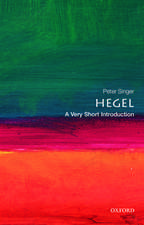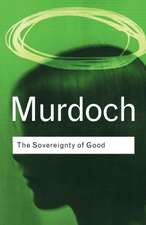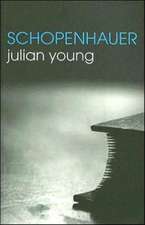Aesthetics and Morals in the Philosophy of David Hume: Routledge Studies in Eighteenth-Century Philosophy
Autor Timothy M Costelloeen Limba Engleză Hardback – 16 mai 2007
The first aim is realized in chapters 1-4. Chapter 1 examines Hume's essay "Of the Standard of Taste" to understand his search for a "standard" and how this affects the scope of his aesthetics. Chapter 2 establishes that he treats beauty in nature and art and moral beauty as similar in kind, and applies the conclusions about his aesthetics to his moral thought. Chapter 3 solves a puzzle to which this gives rise, namely, how individuals both accept general standards that they also contravene in the course of aesthetic and moral activity. Chapter 4 takes up the normative aspect of Hume's approach by understanding moral character through his view of moral beauty.
The second aim of the book is realized in chapters 5-7 by entertaining three objections against Hume's moral philosophy. First, if morality is an immediate reaction to the beauty of vice and the deformity of virtue, why is perfect virtue not the general condition of every human individual? Second, if morality consists of sentiments that arise in the subject, how can moral judgments be objective and claim universal validity? And third, if one can talk of "general standards" governing conduct, how does one account for the diversity of moral systems and their change over time? The first is answered by showing that like good taste in aesthetics, 'right taste' in morals requires that the sentiments are educated; the second, by arguing against the view that Hume is a subjectivist and a relativist, and the third (chapter 6), by showing that his approach contains a view of progress left untouched by any personal prejudices Hume himself might harbor. The book concludes in chapter 7 by showing how Hume's view of philosophy affects the scope of any normative ethics.
| Toate formatele și edițiile | Preț | Express |
|---|---|---|
| Paperback (1) | 479.85 lei 6-8 săpt. | |
| Taylor & Francis – 16 iun 2009 | 479.85 lei 6-8 săpt. | |
| Hardback (1) | 1270.19 lei 6-8 săpt. | |
| Taylor & Francis – 16 mai 2007 | 1270.19 lei 6-8 săpt. |
Din seria Routledge Studies in Eighteenth-Century Philosophy
-
 Preț: 326.49 lei
Preț: 326.49 lei -
 Preț: 311.33 lei
Preț: 311.33 lei -
 Preț: 311.41 lei
Preț: 311.41 lei - 9%
 Preț: 934.94 lei
Preț: 934.94 lei -
 Preț: 389.66 lei
Preț: 389.66 lei -
 Preț: 383.63 lei
Preț: 383.63 lei -
 Preț: 447.17 lei
Preț: 447.17 lei -
 Preț: 479.85 lei
Preț: 479.85 lei -
 Preț: 436.14 lei
Preț: 436.14 lei -
 Preț: 394.51 lei
Preț: 394.51 lei - 18%
 Preț: 1001.84 lei
Preț: 1001.84 lei - 20%
 Preț: 276.49 lei
Preț: 276.49 lei -
 Preț: 326.49 lei
Preț: 326.49 lei -
 Preț: 410.46 lei
Preț: 410.46 lei -
 Preț: 436.14 lei
Preț: 436.14 lei -
 Preț: 425.59 lei
Preț: 425.59 lei - 18%
 Preț: 890.74 lei
Preț: 890.74 lei -
 Preț: 405.66 lei
Preț: 405.66 lei - 17%
 Preț: 259.31 lei
Preț: 259.31 lei -
 Preț: 385.41 lei
Preț: 385.41 lei - 16%
 Preț: 275.88 lei
Preț: 275.88 lei - 18%
 Preț: 1004.06 lei
Preț: 1004.06 lei -
 Preț: 286.51 lei
Preț: 286.51 lei -
 Preț: 389.66 lei
Preț: 389.66 lei -
 Preț: 490.25 lei
Preț: 490.25 lei - 16%
 Preț: 260.13 lei
Preț: 260.13 lei - 18%
 Preț: 1006.60 lei
Preț: 1006.60 lei - 18%
 Preț: 882.69 lei
Preț: 882.69 lei -
 Preț: 428.31 lei
Preț: 428.31 lei - 18%
 Preț: 1006.92 lei
Preț: 1006.92 lei - 18%
 Preț: 899.26 lei
Preț: 899.26 lei
Preț: 1270.19 lei
Preț vechi: 1549.00 lei
-18% Nou
Puncte Express: 1905
Preț estimativ în valută:
243.04€ • 253.76$ • 201.15£
243.04€ • 253.76$ • 201.15£
Carte tipărită la comandă
Livrare economică 04-18 aprilie
Preluare comenzi: 021 569.72.76
Specificații
ISBN-13: 9780415955881
ISBN-10: 0415955882
Pagini: 160
Dimensiuni: 156 x 234 x 14 mm
Greutate: 0.39 kg
Ediția:1
Editura: Taylor & Francis
Colecția Routledge
Seria Routledge Studies in Eighteenth-Century Philosophy
Locul publicării:Oxford, United Kingdom
ISBN-10: 0415955882
Pagini: 160
Dimensiuni: 156 x 234 x 14 mm
Greutate: 0.39 kg
Ediția:1
Editura: Taylor & Francis
Colecția Routledge
Seria Routledge Studies in Eighteenth-Century Philosophy
Locul publicării:Oxford, United Kingdom
Public țintă
PostgraduateCuprins
1. General Rules and 'Of the Standard of Taste' 2. Aesthetic Beauty and Moral Beauty 3. Antinomy and Error 4. Reflection and Character 5. Beauty and Moral Life 6. Progress and Prejudice 7. Philosophy and Moral Life
Recenzii
"Timothy Costelloe sets two tasks for himself in his thought-provoking Aesthetics and Morals in the Philosophy of David Hume: to make a contribution to our understanding of Hume’s aesthetics, and then to use that contribution to throw light on Hume’s theory of morals. Costelloe is a graceful writer with an impressive grasp of the whole of Hume’s corpus. He is consistently engaging, his interpretations are consistently suggestive, and the comparisons that his powerful grasp of Hume’s writings allow him to make are consistently striking." -- James Shelley, Department of Philosophy, Auburn University
Notă biografică
Timothy M. Costelloe is Assistant Professor of Philosophy at The College of William and Mary.
Descriere
This book examines Hume's philosophy with a view to realizing two aims. First, to examine the extent and significance of the connection between Hume's aesthetics and his moral philosophy; and, second, to consider how, in light of the connection, his moral philosophy addresses central questions in ethics.


















![British Empirical Philosophers (Routledge Revivals): Locke, Berkeley, Hume, Reid and J. S. Mill. [An anthology]](https://i4.books-express.ro/bt/9780415537742/british-empirical-philosophers-routledge-revivals.jpg)










